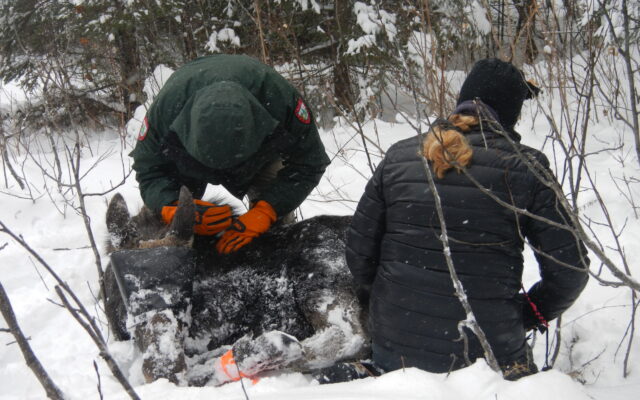
More Maine moose calves are surviving tick infestations this winter
By Pete Warner, Bangor Daily News Staff
A year after the deadliest winter on record for collared moose calves, there’s some encouraging news coming from northern Maine.
Only two of the 70 moose calves captured and collared in January as part of an ongoing study by Department of Inland Fisheries and Wildlife have died, according to moose biologist Lee Kantar.
He delivered the surprising findings on Tuesday at the DIF&W’s Advisory Council meeting to present recommendations for changes to the moose hunt in 2023.
Kantar called the reversal a “stark change” when compared with DIF&W’s sobering data collection in 2022. As part of that ongoing study, also conducted in Wildlife Management District 4, a staggering 87 percent (61 of 70) of collared moose calves did not survive the winter.
That was the highest mortality rate the state had recorded as part of its study.
Maine’s moose population has been severely harmed by winter ticks, which not only have significantly lessened the winter survival of calves but also has led to fewer successful moose pregnancies and twin calf births. This year’s development bucks what has been a disturbing trend for the state’s largest game animal.
The improved survival of the overwintering collared calves this past winter was not completely unexpected. The state since 2006 has been counting winter ticks on moose harvested during Maine’s annual hunting season as part of the registration process at local tagging stations.
And last fall, the results were encouraging.
“One of the things I’ll tell you, while knocking on wood, is that we had the lowest tick count on moose at harvest since 2006,” Kantar told the committee. “And that’s a predictor of what spring mortality looks like from winter ticks.”
Kantar said it is good trend data, but is not absolute.
“Realizing it is one year of 17, it is positive to have low winter tick counts,” Kantar said. “However, population growth and decline in a moose population and the impacts of winter tick on mortality and reproduction is felt over the course of several years.”
Fewer ticks on harvested moose translates to fewer ticks on living animals during the ensuing winter. And fewer ticks means a better chance of survival for the calves, especially when winter severity is reduced.
However, it’s not quite that simple.
“Because of the changes in climate and the shorter winters and the way the forest is harvested, it’s really complex,” Kantar said.
He stressed that the state has been fortunate that its moose research has captured back-to-back years of extremes on the tick-related winter tick mortality spectrum.
Kantar said he is guardedly optimistic about this year’s calf survival, but stressed that April is usually “the time of death” for tick-infested calves.
“Normally we would expect quite a bit of mortality in March and then really go up in April, so you’re kind of biting your fingernails, waiting for the other shoe to drop,” he said.
If the high survival rate continues, DIF&W biologists will have valuable information about the conditions that made it possible.
“One good year will likely benefit survival and productivity and provide population growth in the short term, but without a crystal ball we will have to wait and combine this with other collected data to measure the long term impacts of this,” Kantar said.